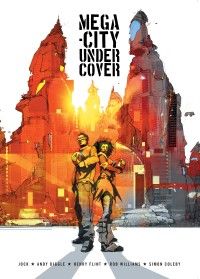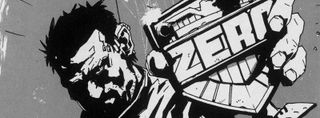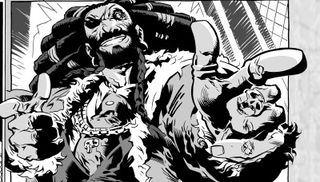SFX readers are very familiar with Judge Dredd and the world of Mega-City One from the pages of 2000 AD . But Dredd and fellow Lawmaster-riding figures are by not the only way justice is enforced: to keep peace amid the millions of citizens, Mega-City One also boasts its undercover Judges, the detectives who mingle with the population at large. Lenny Zero and Lowlife are two 2000 AD tales set in the murky realm of the uniformless "Wally Squad", and since they’re being collected together this March into one volume ( Mega-City Undercover ), we took the opportunity to speak to the artists and writers who brought this alternative world to life.

LENNY ZERO
Lenny Zero was tired of life as an undercover Judge, but betrayed by the woman he loved he's now on the run in the Big Meg. Lenny Zero , appropriately first appearing in the year 2000, marked the beginning of a collaboration between ex-2000 AD editor Andy Diggle and artist Jock , who have since gone on to work for DC Comics on The Losers and Green Arrow: Year One .
How much was at stake for you guys with this project?
Andy: "I guess it was my reputation that was at stake. It was my first published work, so it was my big chance to demonstrate whether I had the chops to write at a professional level. I was the editor of the Judge Dredd Megazine at the time, so I was in the weird position of commissioning myself, albeit unpaid. It was a way of saving some on the editorial budget, so I could put it towards hiring Frank Miller to draw the cover illustration for the tenth anniversary issue! Frank did draw the cover artwork but it never saw print, for reasons I go into in more detail in my intro to Mega-City Undercover."
Jock: "It was an opportunity to do something of my 'own', even though it was set in Mega-City One. it felt great to have a free reign over what we did with it. Lenny gave me the chance to try things that would later influence a lot of the aesthetics of The Losers for DC Vertigo."

What was the most exciting thing about creating Lenny Zero?
Jock: "Probably the fact that it was the first story I had helped actually create for publication. Comics-wise I had only drawn two Judge Dredd stories before Andy offered me Lenny. it gave me the chance to put my own ideas into a strip."
Were you influenced by the writers and artists who'd worked on 2000 AD in the past?
Andy: "Hugely. I'd grown up reading 2000AD rather than American comics, so that was the baseline of quality for me. I think it's fair to say John Wagner is probably the single biggest influence on my writing style. Fast, dense, violent and darkly funny."
How did you get on with writing about a universe that's been in existence since the 1970s? Were you able to be as flexible as you wanted?
Jock: "I think so, yeah... Mega-City One is such a vast place that you can pretty much imagine anything going on in it and it's fair game! Lenny was a very deliberate crime caper anyway, so it totally fits with the established world."
Andy: "One of the great thing's about the Dredd universe is that there are so many crazy ideas lying around like forgotten toys, just waiting to be picked up and played with. I've been reading those stories since I was 10 years old, so I feel very much at home there, infinitely more so than, say, the DC Universe, which I find can be insular and alienating."
And how was it working with each other for the first time?
Andy: "Exhilarating. I'd spotted his artwork in the editorial slush pile and it really leapt out at me. The energy, the design sense, the knack for storytelling. Jock just gets it. It was amazing seeing him bring to life these characters and situations that previously had existed only in my head. Jock's the perfect artist for the Dredd universe because he can bring that crazy, futuristic Mega-City vibe but still populate it with plausible-looking people who look like they live and breathe and emote. That's a tough balancing act, and Jock does it better than anyone."
Jock: "Fantastic - something just clicked and I haven't been able to shake him off ever since! Wouldn't want to either…"

What lessons did you learn from working on Lenny Zero?
Andy: "Shorter is better. Density is king. Comics shouldn't pretend to be film or TV - you can't get away with endless pages of talking heads without putting the reader to sleep. That decompression shit is stale. Gotta keep those twists and turns coming, keep the pages flipping."
Quite a few years have passed since first working on together on this: how do you feel about the stories now?
Jock: "Inevitably I'm critical of my art. It's been long enough now to be a little more objective and there are definitely things in there that I wouldn't do now. But I don't want to be all 'George Lucas' about it - that was where I was at the time and there are different strengths to it too."
Andy: "I have a great deal of fondness for the character, but when I look at my own storytelling all I can see are the flaws. So it's kind of rough around the edges, but I guess it has that crackle and energy of a newbie writer who was out to prove something, cocky little bastard that I was."
What's one reason above all that people who've never seen Lenny Zero before should go and check it out now?
Jock: "It's got more plot twists and turns than a headless mutie haggis on hogmanay, and killer heist concepts to keep you guessing till the very end…"
Andy: "That first Lenny Zero yarn has more story in 10 pages than most modern 'decompressed' comics fit into six issues. Density is the new decompression, baby!"
Cheers, guys!
LOWLIFE
Mega-City Undercover also features the complete (to date) Lowlife - we follow Mega-City One Judges Aimee Nixon and Dirty Frank as they infiltrate criminal organisations in the roughest parts of the Big Meg. Written by Rob Williams and first appearing in 2004, Lowlife features artwork by Henry Flint and Simon Coleby.
The characters of Aimee Nixon and Dirty Frank - were they inspired by anybody? How much did you enjoy working with them?
Rob: "Aimee wasn’t really inspired by anyone per se. Although the fact that she’s the ultimate liar, unreadable by any lie detector, and is named Nixon isn’t exactly a coincidence."
Henry: "Aimee Nixon is based on Courtney Love and Dirty Frank is based on Alan Moore."
Rob: "Dirty Frank, visually, was drawn to be a dead ringer for Alan Moore, which was down to Henry - a genius choice, that. Frank’s tendency for speaking in the third person in a self-aggrandising manner came from watching Premiership footballers, particularly Tony Adams, being interviewed. It always seemed slightly mad to me. They were great fun to write, both of them. Aimee for her self-serving survival instinct, even though she’s our ‘heroine’, she’s really the 'low life' of the title. Frank was great because of his insanity - the silliest thing you’d think of, Frank would do. I’d usually end up giggling to myself while writing his more ludicrous statements, which was either a good sign for the strip… or me slipping into dementia."

And is the Wally Squad a good unit to set a story around?
Rob: "All stories need drama and tension to be successful, so placing a Judge undercover is a great hook. You’ve putting the lead character in danger and the stakes are immediately high - if their true identity is discovered, they’re dead. Add the hyper-rich, heightened, bug-fuck crazy setting of Judge Dredd’s Mega City One and you have the ingredients for a great comic book."
Henry: "Undercover cops in a future city, it's such a simple idea. Add a little bit of Blade Runner with neon lights shining in wet sidewalks... all that's lovely to draw!"
What were your influences while working on this book?
Rob: "The direct influences for Lowlife really came from outside the comic world - the US television show The Shield. Raymond Chandler. What did kind of flow into the strip almost subconsciously though was the feel of Mega-City One, and that comes from reading 2000AD since I was a kid and absorbing the outstanding stories of John Wagner and Alan Grant. The type of crazies that inhabit the city, the bonkers architecture, the general sense of balancing a believable reality with the madness and darkness of that environment, it all seemed to come fairly naturally as I’d been reading that world for something like 20 years now."
Henry: "I say Brandon McCarthy - I love his 'Atlantis' Dredd story. Also a bit of Steve Dillon. Trying to move away from the obvious Bolland and McMahon influences, as fantastic as they are."
Henry, what was the most exciting thing about drawing Lowlife?
Henry: "The lead Wally squad Judge, Aimee Nixon. On paper she sounded cool. I didn't what to fix her down with a look. I planned to change her outfit and hair for each story and in the end managed three costume changes in the first story and two in the second. I only did those two
stories but I'd dozens of looks planned for more episodes. Also, I was getting into black and white and creating patterns with Photoshop and really having fun with design. I even insisted on doing the title logo and incorporating it into the artwork. I think I had Brandon McCarthy in the back of my mind while doing this."
What were your fears about writing a 2000 AD story, Rob? Did you overcome them?
Rob: "I feared unleashing the terrifying fury of the 2000 AD message boarders if I got it wrong! Also, I didn't want to let the setting down. This is Dredd’s world we’re dealing with, albeit a very dark corner of Dredd’s world. It had to fit in and feel recognisable. Aside for that, I wanted to tell a good story. I think we achieved that. I’m very proud of the Lowlife stories."
Rob, what was it like working with two different artists? Was there a big difference between each of them in terms of how you collaborated?
Rob: "Both were great. Henry Flint, I didn’t talk to that much when we did the first two Lowlife stories, but his storytelling instinct is spot on. The pages would come back exactly as I’d written them but somehow better. He was always respectful to what you wanted but he also added things along the way. I think Henry’s a bit of a genius. His imagination and visuals are astonishing, unique and completely bonkers at times, yet his storytelling is as tight as they come - he makes outstanding dramatic choices. He’s probably the most underrated artist in the comic industry."
And what about Simon Coleby?
Rob: "The process with Simon was different as we talked a lot throughout, knocked ideas back and fore. It was a more direct collaboration, which I enjoyed. I loved his heavy blacks - his pages always have a superb feel of weight and substance, which is absolutely perfect for a noir strip like Lowlife. There’s a real punky energy to his art too, which suited the grubby aesthetic. In terms of out-and-out fun, the Rock And A Hard Place story we did together is one of the favourite things I’ve ever done. Our Christmas story, too, that’s a real favourite. I was very lucky to have two great artists on these Lowlife stories."
And Henry, what was Rob like?
Henry: "Like John Wagner, Rob knows how to sneak humour into claustrophobically dark stories."
This collection has been a little while coming - do you look back with fondness on those original stories?
Rob: "I do, yes. It was my third project for 2000AD and probably the first thing that I felt I actually got right. The first two stories are as good as anything I’ve ever written. I love the finale to the initial tale - that’s about as dark and nasty a conclusion as I think I could’ve come up with, but it felt right because it was absolutely true to the character. And Rock And A Hard Place was great fun in a Spinal Tap way, allowing me to take the piss out of the quality-dubious rock music I’ve spent most of my life listening to. I like pretty much all the Lowlife stories. I think it’s only Con Artist where maybe the standard slipped a little. But no one gets it right all the time."
And have you learned any lessons from those early days?
Henry: "The lesson for me in this one is faces - it's faces that tell the story, specially a crime story."
Rob: "If you get the character right from the start (which I think I did with Aimee Nixon), if you get them fully rounded and three-dimensional in your mind and have their entire history planned out before you begin scripting, they’ll probably virtually write themselves! You get an instinctive feel for how they’ll react in any given situation. That’s a real high as a writer, when you almost feel that the characters are speaking to you. The other lesson is that if I’m writing a script and giggling at the jokes myself, to trust that that will transfer to the final strip. Dirty Frank always made me laugh, which is no bad thing."
So, what's the main reason for a person checking out Lowlife these days?
Henry: "It's a good read with ace artwork."
Rob: "The art of Henry Flint and Simon Coleby should be enough of a selling point! These are some wonderful looking comics. And hopefully the scripts aren’t bad too. You’ve got drama, action, a touch of social politics and some thoroughly silly insane comedy for good measure. This is the nastiest part of Dredd’s city - an area where even the Judges don’t go too often. Someone has to police this area, go undercover and find out what the scumbags are really up to. But if the person doing that is secretly as bad as the criminals... what happens then?"
Thanks, guys!

These stories are collected in Mega-City Undercover , available from March 2008 from bookshops or from www.2000adonline.com for £12.99. You can read more about 2000 AD in a forthcoming issue of SFX, and remember, if you want to celebrate St Patrick's Day under the protection of Judge Dredd, check out this t-shirt .
All artwork: 2000 AD, TM and (c) Rebellion A/S
